Somali cuisine
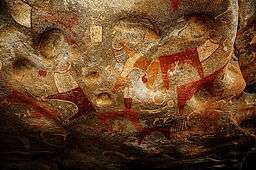 |
| Part of a series on the |
| Culture of Somalia |
|---|
| Culture |
| People |
| Religion |
| Language |
| Politics |
|

Somali cuisine varies from region to region and is a fusion of different Somali culinary traditions, with some East African, Arab, Ethiopian, Yemeni, Persian, Turkish, Indian, and Italian influences. It is the product of Somalia's tradition of trade and commerce. Some notable Somali delicacies include sabayad, lahoh/injera, halva, sambuusa, basbousa, and ful medames.
Breakfast
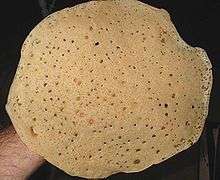
Breakfast (quraac) is an important meal for Somalis, who often start the day with some style of tea (shahie) or coffee (qaxwa). The tea is often in the form of haleeb shai (Yemeni milk tea) in the north. The main dish is typically a pancake-like bread (canjeero or canjeelo) similar to Ethiopian injera, but smaller and thinner. It might also be eaten with a stew (maraqe) or soup.[1]
- Canjeero is eaten in different ways. It may be broken into small pieces with ghee (subag) and sugar. For children, it is mixed with tea and sesame oil (macsaaro) until mushy. There may be a side dish of liver (usually beef), goat meat (hilib ari), diced beef cooked in a bed of soup (suqaar), or jerky (oodkac or muqmad), which consists of small dried pieces of beef, goat or camel meat, boiled in ghee.
- Lahoh is a pancake-like bread originating in Somalia, Djibouti, and Yemen.[2][3] It is often eaten along with honey and ghee, and washed down with a cup of tea. During lunch, lahoh is sometimes consumed with curry, soup, or stew.
- Sabayad or Kimis is another type of flatbread similar to injera/lahoh, as well as the Indian paratha.
- Polenta (mishaari) or porridge (boorash) with butter and sugar is eaten in the Mogadishu area. Elsewhere in the south, such as in the Merca region, special bread known as rooti abuukey with tea is preferred. This is also known as muufo, and is cooked in a special clay oven by sticking the mixture to the walls and waiting for it to fall off when done.[4]
Flatbread referred to as rooti is consumed in the north. Nationally, a sweeter and greasy version of canjeero known as malawax (or malawah) is a staple of most home-cooked meals.
Lunch
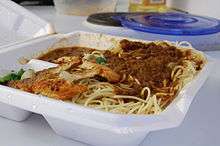
Lunch (qado) is often an elaborated main dish of pasta (baasto) or rice (bariis) spiced with cumin (kamuun), cardamom (heyl), cloves (qaranfuul), and sage (Salvia somalensis). The diffused use of pasta (baasto), such as spaghetti,[5] comes from the Italians. It is frequently presented with a heavier stew than the Italian pasta sauce. As with the rice, it is often served with a banana.
Spaghetti can also be served with rice, forming a novelty dish referred to as "Federation". The dish is usually served with equal (whole) portions of rice and spaghetti, split on either side of a large oval plate. It is then layered with assorted stewed meats and vegetables, served with salad and an optional banana. It has been suggested that the name of the dish is derived from the union of two dishes in Somalia and also from the size and quantity of the food. You will not find this dish served in the average Somali household, since it is uncommon to cook both rice and pasta in one meal. It is instead more common to order the dish from traditional Somali restaurants, where both rice and spaghetti are always readily available. Hence, its novelty status.
In the south, Iskudhexkaris, a hot pot of rice, vegetables and meat, is a regional staple. Beyond the many styles of stew (maraq), rice is usually served with meat and/or a banana on the side. In Mogadishu, steak (busteeki) and fish (kalluun/mallaay) are widely eaten.
Somalis commonly consume a soft cornmeal referred to as soor. It is mashed with fresh milk, butter and sugar, or presented with a hole in the middle filled with maraq.
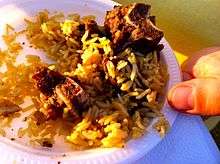
A variation of the Indian chapati is the sabaayad/kamis. Like the rice, it is served with maraq and meat on the side. The sabaayad of Somalia is often somewhat sweet, and is cooked in a little oil.
Italian Polenta, called Sor in Somalia, is used in the Benadir area, mainly around Merca and Jowhar.
Popular drinks at lunch are balbeelmo (grapefruit), raqey (tamarind) and isbarmuunto (Lemonade). In Mogadishu, cambe (mango), zaytuun (guava) and laas (Lassi) are also common. In Hargeisa in the northwest, the preferred drinks are fiimto (Vimto) and tufaax (apple).
Dinner
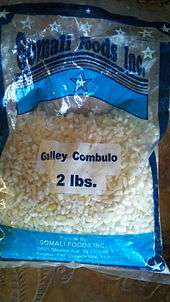
Dinner (casho) in Somalia is served as late as 9 pm. During Ramadan, supper-time often follows Tarawih prayers, sometimes as late as 11 pm. Cambuulo, a common dinner dish, is made from well-cooked azuki beans mixed with butter and sugar. The beans, which on their own are referred to as digir, can take up to five hours to finish cooking when left on the stove at a low temperature. Qamadi (wheat) is also used; cracked or uncracked, it is cooked and served just like the azuki beans.
Rooti iyo xalwo, slices of bread served with a gelatinous confection, is another dinner dish. Muufo, a variation of cornbread, is a dish made of maize and is baked in a foorno (clay oven). It is eaten by cutting it into small pieces, topped with sesame oil (macsaro) and sugar, then mashed together with black tea.
Before sleeping, a glass of milk spiced with cardamom is often consumed.
Snacks
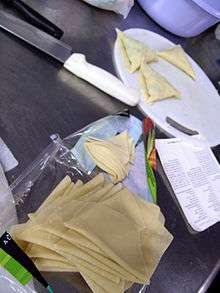
Sambusa, the Somali variation of the Indian samosa, is a triangular snack that is commonly eaten throughout Somalia during the afur (iftar). The Somali version is spiced with hot chili pepper, and the main ingredient is often ground meat or fish. Bajiye, the Somali variation of the Indian pakora, is a snack eaten in southern Somalia. The Somali version is a mixture of maize, vegetables, meat and spices, which is then deep fried. It is eaten by dipping it in bisbaas (hot sauce). Kabaab is a snack eaten by southern Somalis. The Somali version is a mixture of ground meat, potatoes, onions and vegetables, which is then coated with flour and deep fried. Fruits such as mango (cambo), guava (Seytuun), banana (moos) and grapefruit (liinbanbeelmo) are eaten throughout the day as snacks.
Sweets
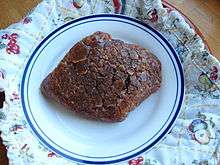
- Xalwo (halwo) or halva is a popular confection served during special occasions,[6] such as Eid celebrations or wedding receptions. Xalwadii waad qarsatey! ("You hid your xalwo!") is the phrase that follows a person who has eloped or has a small, private wedding. Xalwo is made from sugar, cornstarch, cardamom powder, nutmeg powder, and ghee. Peanuts are also sometimes added to enhance texture and flavor.[7]
- Gashaato, Kashaato or Qumbe, made from coconut, sugar and oil, which is spiced with cardamom, is a much-loved sweet. The sugar is brought to a boil with a bit of water, then the cardamom is added, followed by shredded coconut.
- Lows iyo sisin is a favorite sweet in the south. It consists of a mixture of peanuts (lows) and sesame seeds (sisin) in a bed of caramel. The confection sticks together to form a delicious bar.
- Jalaato, similar to the American popsicle, is made by freezing naturally sweet fruits with a stick in the middle. More recently in Mogadishu (Xamar), it has grown to include caano jalaato, which is made with milk and requires sugaring up. The word jalaato comes from gelato, which is Italian for "frozen".
- Buskut or Buskud comprises many different types of cookies, including very soft ones called daardaar (literally "touch-touch" due to its smooth, delicate texture).
- Doolshe encompasses many delectable styles of cakes.
- Icun is a sweet mostly eaten by southern Somalis. It is made from sugar and flour mixed with oil. People prefer to say Icun I calaangi caloosha I gee (Eat me, chew me, then take me to your stomach) when they see it. It is mainly eaten during weddings and Eid times, but southern Somalis always make it at home and eat it as part of a dessert.
- Basbousa is a traditional Somali sweet cake.[8] It is made from cooked semolina or farina soaked in simple syrup.
There are many sweets eaten during festive occasions, such as weddings, parties or Eid. Among these are baalbaaloow, shuushuumoow, bur hindi, bur tuug, and qumbe (coconut), the latter of which is made from coconuts mixed with sugar to form a bar.
After-meal

Somalis traditionally perfume their homes after meals. Frankincense (luubaan) or a prepared incense (uunsi), known as bukhoor in the Arabian Peninsula, is placed on top of hot charcoal inside an incense burner or censer (a dabqaad).[9] It then burns for about ten minutes. This keeps the house fragrant for hours. The burner is made from soapstone found in specific areas of Somalia.
See also
- Cuisine of the Horn of Africa
- Arab cuisine
- List of African cuisines
-
 Africa portal
Africa portal -
 Food portal
Food portal -
 Somalia portal
Somalia portal
Notes
- ↑ Abdullahi, pp.111-114.
- ↑ Mohamed Diriye Abdullahi, Culture and Customs of Somalia, (Greenwood Press: 2001), p. 113.
- ↑ Little Business Women
- ↑ "Somali Polenta Flat Bread (Muufo)". The Somali Kitchen. Retrieved 8 March 2015.
- ↑ Somalian recipes (in Italian)
- ↑ "Somali Halwa." Mysomalifood.com. Accessed July 2011.
- ↑ Ali, p. 79
- ↑ "The Recipes of Africa". p. 241. Retrieved 2014-07-18.
- ↑ Abdullahi, pp.98-99
References
- Ali, Barlin (2007). Somali Cuisine. AuthorHouse. ISBN 1-4259-7706-5.
- Abdullahi, Mohamed Diriye (2001). Culture and customs of Somalia. Greenwood. ISBN 978-0-313-31333-2.
External links
| Wikimedia Commons has media related to Cuisine of Somalia. |